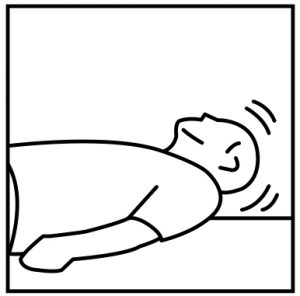Seizure
 Seizures are caused – as are altered states of consciousness – by disturbances in brain function. Medical causes can be: epilepsy, brain tumours, inflammation of brain structures, hypoglycaemia and others. Seizures can affect the entire body (generalized) or discrete parts. Falls in children may lead to injuries of the head and/ or spinal column. Young children are also susceptible to fever-induced seizures. These seizures, called febrile convulsions, occur during the ages of 6 months to 5 years in approximately 3 to 4 % of all children.
Seizures are caused – as are altered states of consciousness – by disturbances in brain function. Medical causes can be: epilepsy, brain tumours, inflammation of brain structures, hypoglycaemia and others. Seizures can affect the entire body (generalized) or discrete parts. Falls in children may lead to injuries of the head and/ or spinal column. Young children are also susceptible to fever-induced seizures. These seizures, called febrile convulsions, occur during the ages of 6 months to 5 years in approximately 3 to 4 % of all children.
Symptoms are
- Altered states of consciousness (leading up to, and including, unconsciousness)
- Uncontrolled twitching
- Involuntary urination/defecation
First Aid Measures
- Dial the emergency number 144 (get someone else to dial it)
- Remove endangering objects from the surrounding area
- Protect the head from impact
- After the seizure: prevent respiratory obstruction and eventual hypothermia
- If cervical spine injury cannot be excluded: apply manual inline stabilisation
Also Note
While protecting the head, hold the head gently and allowing movement, in order to prevent total restriction of the head and thus risking potential cervical injury.
Seizures are usually self limiting. Nevertheless, always notify the emergency services. A seizure lasting for more than several minutes can become life threatening and needs to be medically interrupted by the emergency services.
If possible, inform the emergency services about seizure duration.
Febrile convulsions last only a few minutes and are usually harmless. Nevertheless, an immediate medical follow-up at the hospital is recommended, because in rare cases dangerous medical causes (for example meningitis) may have caused the seizure.
Advanced subjects
Fever / Febrile convulsions
Meningitis
Tetanus